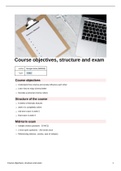Course objectives, structure and exam
author Giorgia Sisto (580263)
Type extra
Course objectives
Understand how cinema and society influence each other
Learn how to enjoy cinema better
Develop a personal cinema culture
Structure of the course
8 weeks of thematic lectures
week 4 is completely online
mid-term exam in week 5
final exam in week 9
Mid-term exam
multiple choice questions - 20 MCQ
2 short open questions - 200 words each
Referencing (director, country, year of release)
Course objectives, structure and exam 1
, Week 1 - Memory
author Giorgia Sisto (580263)
Type Lecture
Avatar & James Cameron
“When you start looking at something on a phone, you’re sort of missing the point.
Going to a movie theater is less about the size of the screen and the perfection of
the sound system. And it’s more about a decision to not multitask.”
Memory
Memory: The power or process of remembering what has been learned.
Memory: The processes that are used to acquire, store, retain and later retrive information.
Data information knowledge: Information is created when data are processed, organized, or structured to
provide context and meaning. Information is essentially processed data = knowledge is what we know.
3 major processes are involved in memory:
1. Encoding: acquiring data that is worth remembering
2. Storage: data are stored in different parts of our brain depending on their importance
3. Retrieval: requesting access the data stored
Week 1 - Memory 1
, 📌 green valley knight red black eyes yellow horse blue sheep white warrior dragon pink cloud
purple
How many words can you remember?
The green knight was riding a black horse in the blue valley when he met a red dragon with yellow eyes. The scare
And now?
Stories help us make sense of the world!
Can a society have memory?
Societies require continuity and connection with the past to preserve social unity
and cohesion.
- Emily Durkheim (1858-1917)
Maurice Halbwachs (1877-1945) coins the terms ‘collective memory’.
Collective memory: The memory of a group of people, passed from one generation to the next.
This is connected to the idea that to grow, societies need to remember who they are, and where they
come from. According to this idea, societies are developing throughout time always in relation to what
they used to be in the past: perpetuating culture, traditions, ways of saying, and so forth.
How do you create a collective memory?
History
Traditions (they make you feel part of a group)
Lieux de memoire: a symbolic element of the memorial heritage of any community (e.g. trenches,
statues, concentration camps, 9/11 memorial etc.)
"Unité significative, d'ordre matériel dont le travail du temps a fait un
élément symbolique d'une quelconque communauté”
Cultural amnesia: Collective, often deliberate, forgetting of something important by a group (e.g.
pandemic, Dutch golden age, etc.).
blocking: information is available in memory but we can’t retrieve it when we want to (e.g. tip-of-the-
tongue phenomenon)
Week 1 - Memory 2
, 📌 Can cinema contribute to society’s memory?
Society is known to be ‘a group of people with a shared history, who needs a connection to the past to preserve co
We can see cinema within society as a parallel of the 3 major elements constituting memory: information is enc
Cinema is therefore important in what it allows society not to forget: cultural amnesia exactly refers to the collectiv
However, it is also important to bare in mind that not everything shown in movies can be assessed as completely re
One of the greatest examples of the importance cinema is given, with regards to its contribution to society’s memor
about the violence and inhuman treatments that Jewish people underwent in that period.
Can we restore memory?
Waltz with Bashir - animated movie (Ari Folman, Israel, 2008)
Invasion of Lebanon/Peace in Galilea (1982)
Bashir Gemayel (1947-1982, Lebanese president for 20 days)
this animated movie exemplifies the ways in which animated documentary is essential to
show what would be otherwise very difficult to represent in normal movies (e.g. stream of
consciousness, unconscious elements, dreams, imagination, etc.)
nightmarish atmosphere
the scene we saw: a friend tells Bashir (Folman) that we was too scared as a soldier with
killing enemies, so he was assigned to kill dozens of dogs to prevent them to haul as a
warning sign
Screen memory: Distorted memory of early childhood that may mask another memory of deep emotional
significance. Let’s analyze the role of screen memory in Waltz with Bashir:
The whole movie is about false memories and trauma
The director (Folman) struggles to remember his time as a soldier during the Israeli invasion of
Lebanon in 1982 (civil war)
he interviews fellow soldiers, journalists, psychologists, etc
Week 1 - Memory 3





